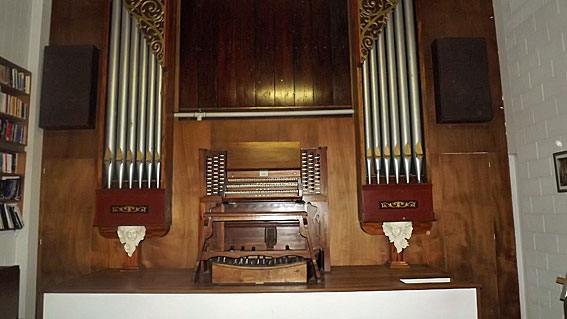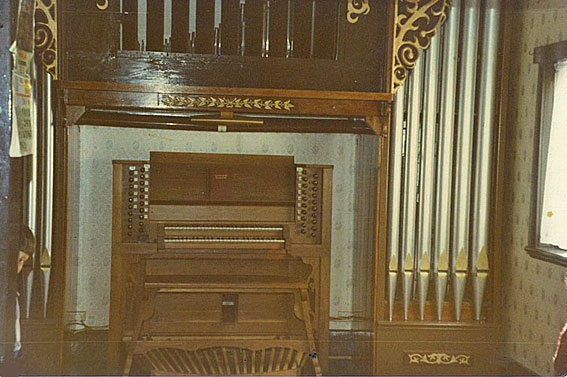
The organ in the residence of Hank Roelofs, Kennedy
[Photograph supplied by Hank Roelofs, September 2015]

The organ in the residence of Hank Roelofs, Kennedy
[Photograph supplied by Hank Roelofs, September 2015]
Historical and Technical Documentation by Geoffrey Cox
© OHTA 2012, 2015 (last updated September 2015))
Located around halfway between Townsville and Cairns in North Queensland, the organ in this residence was built originally by the Charles Dirksen Organ Co. of Brisbane in 1963 for the Church of Jesus Christ of Latter-Day Saints in Fitzroy Terrace, Prospect, South Australia.1
Charles Dirksen, a Dutchman, had trained with the firm of L. Verschueren, Heythuysen, Netherlands, before migrating to Australia. He spent two years in Adelaide before moving to Brisbane in 1956 for his honeymoon. Deciding to stay in Brisbane, he set up his own business there, but returned to Holland around 1963 after a period of ill health. A specialist in pipe-making, Dirksen made his own metal and wooden pipes in Brisbane. Around 1957, he secured a contract to build small extension organs for some 14 Mormon churches around the country.2 Most of these, including this one, were of two ranks. Similar two-rank instruments were supplied by Dirksen in Queensland for the Mormon chapel, Camp Hill (1957), the Mormon Chapel, Toowoomba (1957) and the Mormon Chapel, Chermside (1958).
This instrument was presumably one of the last built by Dirksen before he returned to Holland. It was purchased by Hank Roelofs from the Mormon church in Prospect, South Australia, around 1980, and was installed initially in his residence in Adelaide. Roelofs had become familiar with Dirksen's work while living in Western Australia between 1953 and 1969, during which time he worked for a year with Paul Hufner and was involved in the removal and rebuilding of Dirksen's organ from the Mormon chapel in South Perth.3
Hank Roelofs rebuilt the instrument in Adelaide, replacing the original action with
a new solid-state one incorporating Laukhuff magnets. He made new chests for the pedal towers, and the original (veneered plywood) stop-key console was discarded and replaced by a home-built drawstop console of solid wood, retaining the original keyboards. The manual compass was reduced from 61 to 56 notes in this process, and a new stop (Flute 2ft) was added to the Swell using the pipes rendered redundant. Most of the original pipework is of metal, apart from the bottom octave of the stopped rank (up to tenor d), which is of mahogany. The bottom octave of the open rank is of zinc.4

The rebuilt console and casework of
Dirksen's organ in Adelaide, early 1980s
[Photograph supplied by Hank Roelofs, November 2001]
The nomenclature for the stops was originally the same as for Dirksen's organ in the Mormon Chapel, Toowoomba. Dutch nomenclature was adopted by the present owner in rebuilding the console, although the original specification was initially retained:
| GREAT Sub Bass Praestant Gedekt Octave Flute Quint Octave Piccolo SWELL Sub Bass Praestant Gedekt Octave Flute Nasard Octave Flute Piccolo PEDAL Sub Bass Praestant Gedekt Quint Octave Flute |
16 8 8 4 4 2-2/3 2 1 16 8 8 4 4 2-2/3 2 2 1 16 8 8 5-1/3 4 4 |
A B A B A B B B A B A B A A B A [1990] B A B A A B A |
NO COUPLERS
Tremulant [deleted]
New draw-stop console
Direct Electric Action
Compass: 56/30 [formerly 61/30]
Balanced Swell Pedal.5
After moving to Queensland late in 1983, Hank Roelofs installed the organ in its present location around 1989-90. He always had plans to enlarge the organ, and to replace some of the 'borrowed' stops with independent ranks. By 2001 he had already obtained additional pipework, including a Clarinet 8ft (Tenor C), a metal Principal 4ft, Flute 4ft with pierced stoppers, and a wooden Gedact 8ft.6
In 2003, Roelofs acquired the Hill, Norman & Beard 2-manual 6-rank extension organ built in 1934 for Wesley Chapel, Castlereagh Street, Sydney. The latter had been rebuilt in 1979 by Pitchford & Garside, and removed subsequently to storage at the residence of Brett McKern in Sydney.7
Following delays caused by cyclone Yasi in 2011, the console was enlarged to three manuals and additional pipework was added. By 2015, the proposed specification was given as follows:
| GREAT Bourdon Prestant Holpijp Gemshoorn Baarpijp Octaaf Roerfluit Quint Octaaf Fluit Terts Larigot Piccolo Hobo SWELL Gedektbas Prestant Dulciana Salicionaal Salicet Octaaf Gedekte Fluit Quint Gemshoorn Roerfluit Superoctaaf Sesqualter CHOIR Holfluit Prestant Dulciana Gemshoorn Gedekt Octaaf Nazard Salicetina Superoctaaf Larigot Sifflet Mixtuur Clarinet PEDAL Bourdon Subbass Basquint Prestant Violonbas Gedekt Quint Octaaf Gemshoorn Fluit Woudfluit Trumpet Zink |
16 8 8 4 4 4 4 2-2/3 2 2 1-3/5 1-1/3 1 8 8 8 8 8 4 4 4 2-2/3 2 2 2 II 8 8 8 8 4 4 2-2/3 2 2 1-1/3 1 III 8 16 16 10-2/3 8 8 8 5-1/3 4 4 4 4 8 4 |
COUPLERS
Swell to Pedal
Great to Pedal
Choir to Pedal
Swell to Great
Choir to Great
Swell to Choir
top note octave coupler on Great
Draw-stop console
Radiating concave pedalboard
Electric action
Compass: 56/30
Balanced swell pedal.8
____________________________________________________________________
1 Date from Bruce Naylor, Gazetteer of South Australian Pipe Organs (Melbourne: Society of Organists (Vic) Inc., 1974). Relocation to North Queensland noted by Peter Brandenburg, Cairns, July 2001.
2 Personal communication to G. Cox from John Spall, an employee of Dirksen in Brisbane, 1973.
3 Personal communication to G. Cox from Hank Roelofs, November 2001.
4 Personal communication to G. Cox from Hank Roelofs, August 2001.
5 Specification supplied by Hank Roelofs, August 2001.
6 Personal communication to G. Cox from Hank Roelofs, November 2001.
7 Personal communication to G. Cox from Kelvin Hastie, December 2003. John Maidment, Gazetteer of New South Wales Pipe Organs (Melbourne: Society of Organists (Vic) Inc., 1981).
8 Enlarged specification supplied to G. Cox by Hank Roelofs, September 2015.